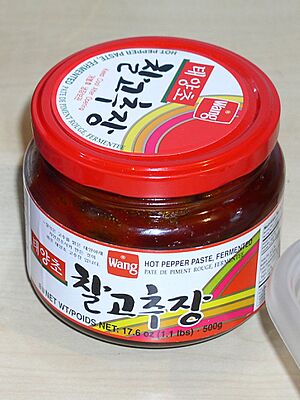Gochujang facts for kids
Gochujang (Korean: 고추장) is a delicious, spicy red paste from Korea. It's a special kind of food that has been fermented. This means its ingredients are left to change over time, which gives Gochujang its unique and deep flavor.
Gochujang is made from red chili, sticky rice, fermented soybeans, and salt. People use it to add a yummy, spicy kick to many Korean dishes. You might find it in popular foods like bibimbap (Korean: 비빔밥), bulgogi (Korean: 불고기), and tteokbokki (Korean: 떡볶이).
Contents
What's Inside Gochujang?
The main things that make up Gochujang are red chili powder, sticky rice powder, and fermented soybeans. Salt is also a very important ingredient.
This paste is not just tasty; it also has some good stuff for you! It contains protein, fats (called lipids), and carbohydrates. It also has fibre, which is good for your digestion. Gochujang has more Vitamin B than some other Korean pastes like doenjang and ganjang. It also contains Vitamin C and carotene.
The spicy taste of Gochujang comes from something called capsaicin. This is a natural chemical found in chili peppers that makes them feel hot. Sometimes, people add salted fish or meat to their Gochujang for extra flavor.
A Quick History of Gochujang
Gochujang, or hot pepper paste, started being made in Korea after chili peppers arrived. This happened in 1592, during the middle of the Chosun Dynasty (Korean: 조선 왕조).
An old book from 1766, called Jung-Bo-Sal-Lim-Kyung-Jae (Korean: 증보살림경제), describes how it was made. It said Gochujang got its flavors from beans, sweetness from sticky rice, heat from red peppers, and saltiness from salt. After this time, making Gochujang quickly became very popular across Korea. Another old book, Nong-Ga-Wol-Lyung-Ga (Korean: 농가월령가), also talks about how to make it.
Different Kinds of Gochujang
There are several types of Gochujang. They are made by adding slightly different ingredients during the making process. The recipes can also be a little different depending on which part of Korea they come from. Here are some common types:
Glutinous Rice Gochujang
This is the most basic and common type. It's made by mixing glutinous rice powder with powdered fermented soybeans and red peppers. These are the main ingredients for all Gochujang.
Kaoliang Gochujang
This type is made by adding kaoliang, which is a type of grain.
Barley Gochujang
This Gochujang is made by adding barley. It is often used as Ssam-Jang (쌈장) during the summer. Ssam-Jang is a thick, spicy dipping sauce.
Wheat Gochujang
This kind of Gochujang is made with wheat. It is often used for making Korean stews, called Jji-Gaes (찌개). It's also used for Jang-A-Jji (장아찌), which are pickled vegetables.
Red-bean Gochujang
This type of Gochujang includes red beans. It's often used to make Cho-Gochujang (초고추장). This is a sweet and sour Gochujang sauce, and the red beans help give it a beautiful red color.
Images for kids
See also
 In Spanish: Gochujang para niños
In Spanish: Gochujang para niños



